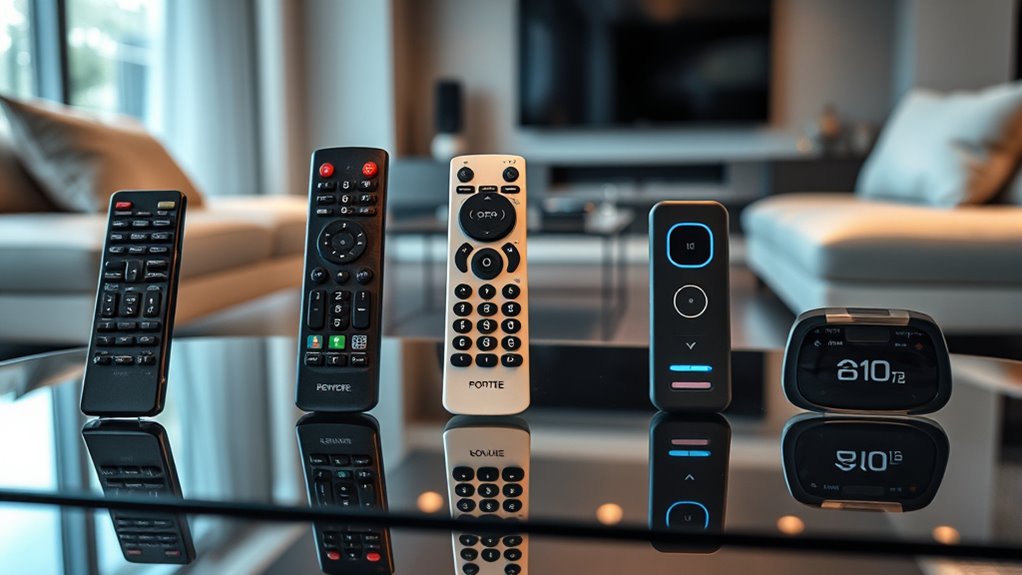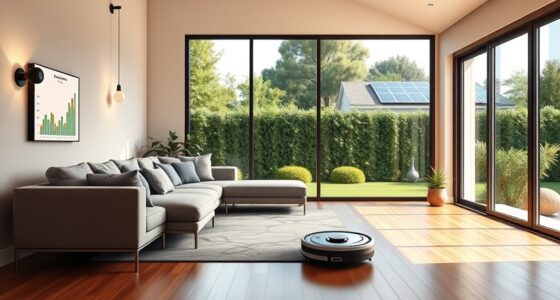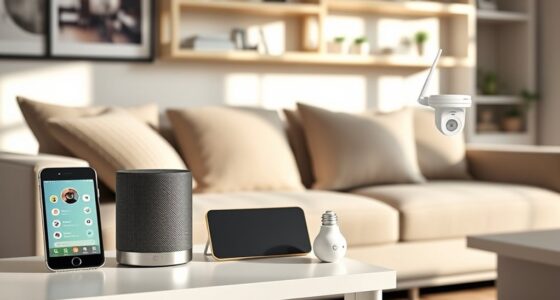The evolution of universal remotes has gone from wired and ultrasonic controls to infrared (IR), then to radio frequency (RF), and now Wi-Fi technology. IR remotes required line-of-sight, but RF and Wi-Fi expand control range, allow devices behind obstacles, and enable remote access via smartphones or smart home systems. If you keep exploring, you’ll discover how these advancements create smarter, more versatile ways to manage your entertainment and home devices effortlessly.
Key Takeaways
- Early remote controls used wired connections before transitioning to wireless infrared (IR) signals in the 1950s.
- Infrared remotes require line-of-sight and are limited by obstacles, prompting a shift to radio frequency (RF) technology.
- RF remotes expanded control range and multi-device management, working through walls and barriers without direct visibility.
- Integration of Wi-Fi and Bluetooth enabled remote control via smartphones, voice commands, and smart home ecosystems.
- Modern remotes now support firmware updates, macro programming, and seamless interoperability across multiple devices and platforms.
The Origins of Remote Controls and Early Innovations

The development of remote controls began with pioneering experiments that harnessed emerging wireless technologies. Nikola Tesla demonstrated one of the earliest wireless remote control devices in 1898, using radio frequency to steer a miniature boat. Early innovations by Leonardo Torres-Quevedo in the early 20th century extended these ideas, creating remote control systems to operate vehicles like tricycles and torpedoes wirelessly. In the 1930s, the first consumer remote controls appeared for radios, though their impact was limited. By 1950, Zenith introduced the Lazy Bones television remote, initially wired before shifting to wireless versions. Eugene Polley’s 1956 Flashmatic used light flashes for control, representing one of the first ultrasonic remote control devices. These early innovations laid the groundwork for today’s versatile remote control technologies. Additionally, the evolution of remote controls has been influenced by advancements in remote control technology, making modern devices more user-friendly and functional.
The Rise of Infrared Technology and Its Limitations
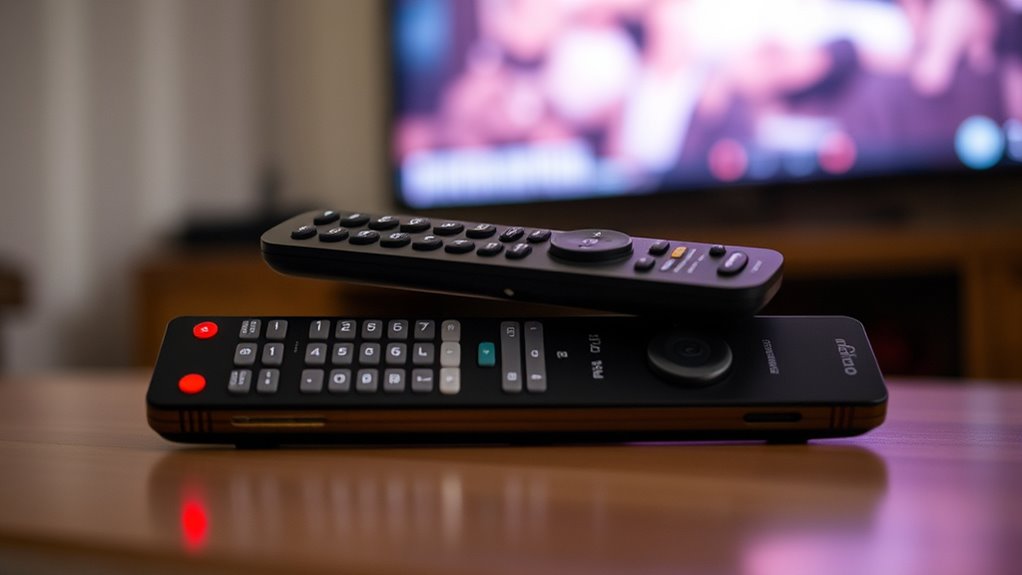
As remote controls evolved from early experiments, infrared (IR) technology became the dominant method for wireless device communication. Infrared remote controls use digitally coded pulses of IR radiation to send commands to devices, but they require a clear line-of-sight for effective operation. This reliance limits control capabilities, especially when obstacles like walls or furniture block signals. Early IR remotes offered basic functions such as volume and channel adjustments, but their control capabilities remained limited. IR technology’s susceptibility to signal interference from external light sources further hampers performance and range. Despite its widespread adoption, IR’s dependence on direct visibility and vulnerability to interference restrict its effectiveness compared to other wireless options, highlighting both its importance and inherent limitations in remote control evolution. Additionally, advancements like wireless communication methods, such as RF and Wi‑Fi, have addressed many of these IR limitations by enabling non-line-of-sight operation and more reliable connectivity. Moreover, ongoing research into improved modulation techniques continues to enhance the robustness and range of remote control signals.
Transition to Radio Frequency Control: Expanding Possibilities
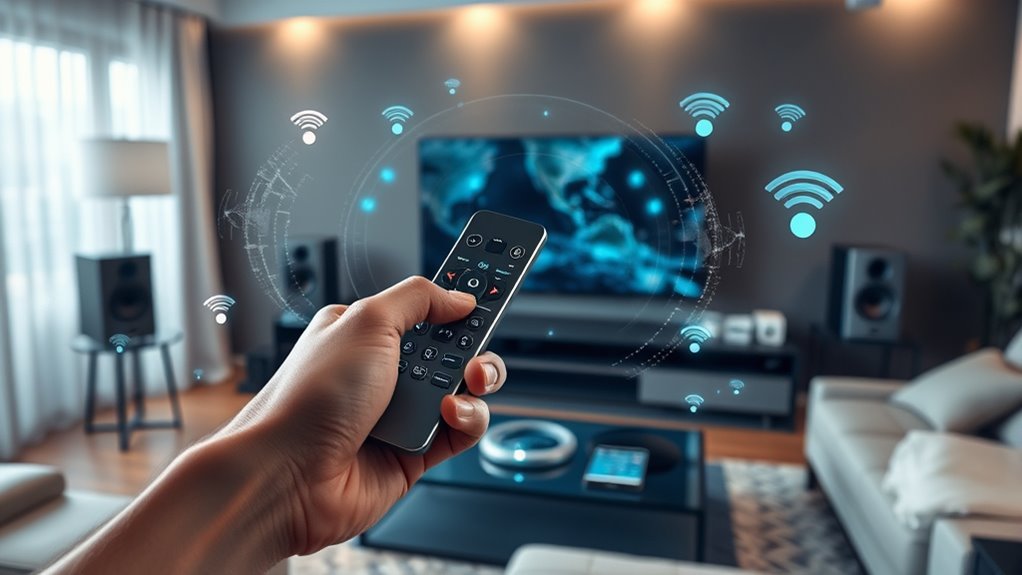
Radio frequency controls considerably expand your remote’s range and flexibility by working through walls and obstacles. They also let you manage multiple devices at once without precise aiming, making your setup more convenient. As RF technology evolves with Wi-Fi and Bluetooth integration, your control options become even more versatile and seamless. Additionally, cost of living adjustments in some advanced remotes can help account for inflation, ensuring long-term value and functionality. Incorporating automation features powered by AI can further enhance your remote’s capabilities for a smarter home experience. Furthermore, the integration of wireless communication protocols allows for easier updates and compatibility with a broad range of smart home devices. Understanding remote control technology can help consumers select the most suitable system for their needs and align their choices with evolving professional and financial trends to maximize efficiency and value.
Wireless Range Enhancement
Have you ever wondered how remote controls can operate through walls and obstacles? The switch from infrared (IR) to RF remote controls dramatically improved wireless range, making this possible. RF remotes can typically work at distances of 30 meters or more, far beyond IR’s limited line-of-sight. This technology uses radio waves that can penetrate barriers, giving you greater flexibility in device placement and control. Moreover, RF remote controls often incorporate essential camping gear principles, ensuring reliable operation even in challenging environments. By utilizing wireless communication techniques, these remotes maintain a stable connection regardless of obstacles. This advancement also benefits home automation systems by enabling more complex and expansive configurations. As a result, RF remote controls can be integrated into smart home ecosystems, offering seamless control over multiple devices simultaneously. Imagine: 1. Controlling your devices from another room without line-of-sight. 2. Seamlessly managing multiple gadgets across larger spaces. 3. Enhancing your home automation with reliable, extended connectivity.
Furthermore, advancements in radio frequency technology have contributed to increased security and reduced interference, ensuring your devices remain protected and responsive. With RF remote controls, you gain more freedom and convenience, transforming your smart home into a truly integrated space. This evolution access new possibilities for wireless range and effortless control.
Multi-Device Operation Capabilities
With RF remote controls, managing multiple devices simultaneously across different rooms has become much easier. This wireless technology enables multi-device operation without line-of-sight, allowing you to control TVs, sound systems, and smart home devices from anywhere within a large range, often over 100 feet. RF remotes support complex setups, seamlessly integrating with smart home systems and wall barriers. These universal remotes simplify your entertainment experience by enabling centralized control and automation. You can operate multiple devices at once, switch between rooms effortlessly, and even incorporate voice commands for added convenience. The shift to RF control has expanded possibilities, making multi-device operation more reliable, flexible, and integrated into modern smart homes. Additionally, advancements in wireless communication protocols have improved signal stability and security, further enhancing user experience. The incorporation of privacy and security features in these protocols helps protect user data and prevent unauthorized access. As industry standards evolve, interoperability between different brands and systems continues to improve, allowing for even more seamless multi-device control. Furthermore, ongoing innovations in energy-efficient technology contribute to reducing power consumption and increasing overall system reliability. Moreover, integrating sustainable and eco-friendly practices into device design can support environmentally conscious usage and reduce overall energy impact.
Barriers and Line-of-Sight
While infrared (IR) remote controls require a clear line-of-sight between the remote and the device, RF remote controls can operate through walls and obstacles. This shift in technology removes the frustration of aiming directly at your device, expanding your remote control range considerably. RF remote controls use wireless communication, allowing you to control devices from across rooms or even outside. This breakthrough enables many new applications, from controlling smart home gadgets to automotive systems. Imagine the freedom of not worrying about obstacles blocking your signal. Feel empowered by reliable control, even when your device isn’t in sight. With RF remotes:
- You eliminate the frustration of line-of-sight limitations.
- You enjoy seamless control through obstacles.
- You open new possibilities for wireless communication and convenience.
Advancements in RF Remote Control Features and Design

Recent advancements in RF remote control features and design have considerably expanded their capabilities and usability. Modern RF remotes now offer wireless connectivity options like Bluetooth and Wi-Fi, enabling seamless integration with smartphones and smart home systems. They support macro programming, allowing you to automate multiple commands with a single press, streamlining your entertainment experience. The extended control range beyond 30 feet means you can operate devices from different rooms effortlessly. Many designs feature compact, ergonomic forms with rechargeable batteries and customizable buttons for personalized control. These improvements make RF remotes more versatile and user-friendly, enhancing smart home automation and multi-device management. Additionally, ergonomic design techniques can be incorporated to improve comfort during extended use, making remote control interactions more intuitive and enjoyable. Incorporating regulatory compliance ensures these devices meet safety and quality standards, further boosting user confidence and device reliability.
The Role of IoT and Smart Devices in Remote Control Evolution

IoT and smart devices are transforming remote control capabilities by enabling seamless communication and centralized management of multiple gadgets. With Wi-Fi, Bluetooth, and voice assistants, you can control devices effortlessly and have them adapt to your routines automatically. This evolution opens up new possibilities for more flexible, intuitive, and integrated home automation.
IoT Integration Benefits
The integration of IoT into remote controls transforms how you manage your smart devices by enabling seamless connectivity and centralized control through a single interface. With IoT, your smart remote controls can connect wirelessly with multiple devices, offering effortless device interoperability. This means you can automate routines, like adjusting lighting or temperature, based on your preferences or schedules. Additionally, IoT-enabled remote controls can be updated remotely via cloud services, ensuring compatibility and improvements without physical reprogramming. Voice commands become more natural and intuitive, allowing you to control everything hands-free.
Here are the key benefits:
- Feel empowered with effortless control over your entire smart home.
- Experience convenience through automated routines tailored to you.
- Stay up-to-date effortlessly with remote firmware updates.
Enhanced Device Interconnectivity
As smart devices become more interconnected, your remote control can communicate seamlessly with multiple appliances via Wi-Fi or Bluetooth, enabling centralized management. IoT integration allows your devices to coordinate effortlessly, reducing manual input. Smart remotes equipped with AI learn your preferences and automate device interactions across interconnected systems. The proliferation of IoT-enabled appliances means you can control and monitor them through smartphone apps, expanding beyond traditional remotes. With 5G networks, responsiveness and reliability improve, ensuring real-time control of multiple smart devices. This enhanced interconnectivity creates a more intuitive, automated home environment where devices communicate without your direct involvement.
| Device Type | Interconnectivity Method |
|---|---|
| Smart TV | Wi-Fi, Bluetooth |
| Smart Speakers | Wi-Fi, IoT protocols |
| Security Cameras | Wireless (Wi-Fi, 5G) |
| Smart Thermostats | Wireless, IoT integration |
| Appliances (Fridge, etc.) | Smartphone apps, IoT platforms |
Future Control Possibilities
Advancements in connectivity and artificial intelligence are transforming remote controls into powerful hubs for managing your entire smart home. With IoT integration, you’ll enjoy seamless control of all devices through centralized platforms or voice commands. Future remotes will leverage artificial intelligence to predict your preferences and automate device interactions, making your daily routines effortless. 5G connectivity ensures real-time control and faster data exchange, enhancing responsiveness. Wi-Fi-enabled remotes will allow firmware updates and new device profiles to be downloaded remotely, expanding compatibility. Additionally, multi-device control ecosystems will unify your home automation, security, and entertainment systems into a single interface. These innovations promise a future where your remote isn’t just a device, but an intelligent, connected control hub for your entire smart home experience.
Modern Applications and Practical Uses of RF and Wi-Fi Remotes
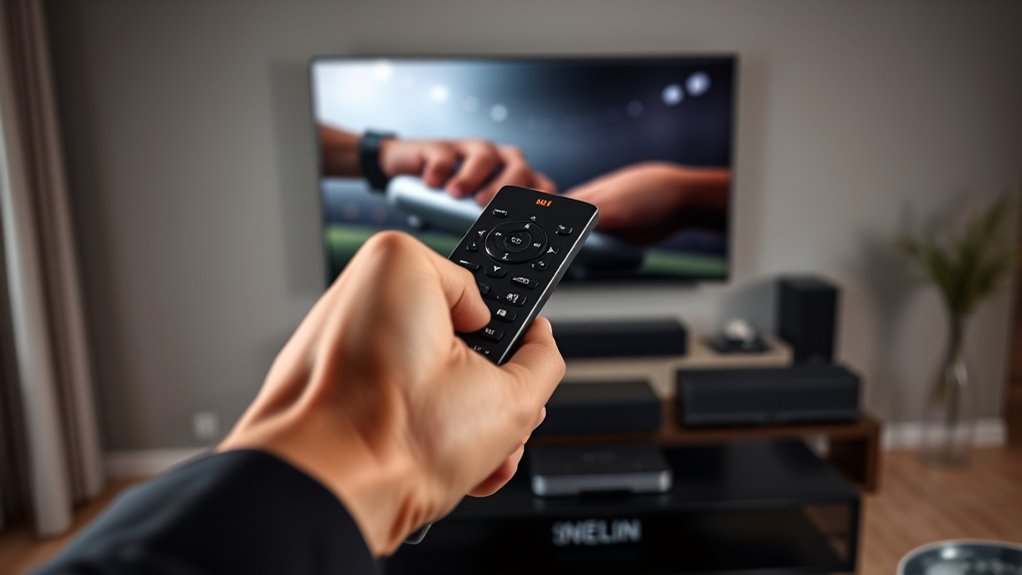
Modern RF and Wi-Fi remotes have transformed the way you control devices, offering greater flexibility by eliminating the need for line-of-sight operation. With these remote controls, you can manage multiple devices seamlessly, whether in large rooms or across your entire home. Wi-Fi remotes connect to smart home ecosystems, enabling you to control lighting, thermostats, and entertainment systems via internet-connected apps from anywhere. RF remotes excel in device management across expansive spaces, providing reliable operation without barriers. Many modern remotes feature voice command capabilities and integration with virtual assistants, making commands even more intuitive. They also support advanced functions like macro commands and firmware updates, allowing customization and enhanced control. These practical applications make RF and Wi-Fi remotes essential tools for modern home automation.
Emerging Trends and Future Developments in Remote Technologies
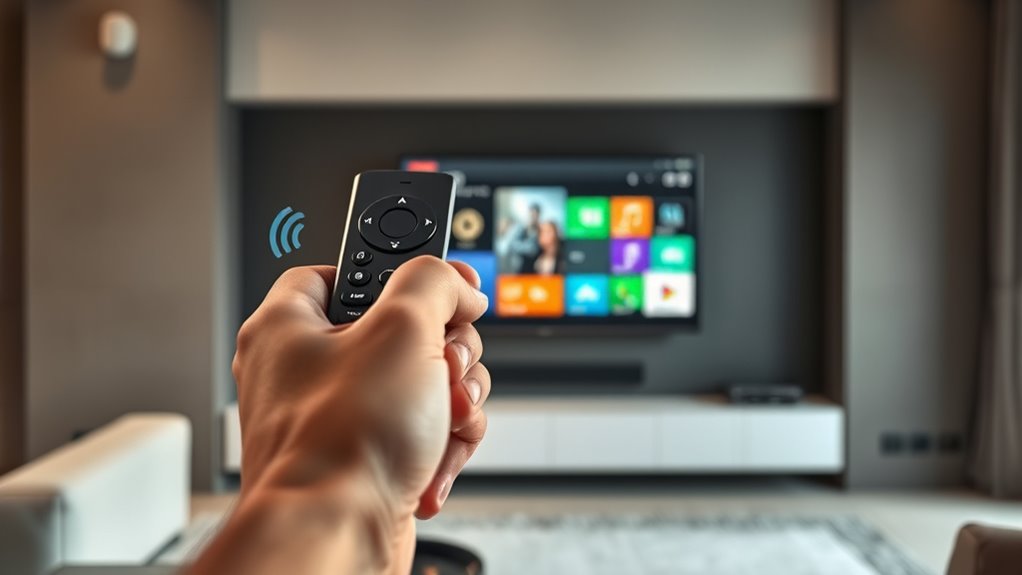
The integration of IoT, AI, and 5G is transforming remote controls into smarter, more connected devices that can anticipate your needs and operate seamlessly across multiple platforms. Future wireless remote controls will feature advanced voice recognition, gesture control, and touchless interfaces, making interactions effortless. Wi-Fi-enabled remotes are increasingly replacing traditional IR and RF devices, giving you control over smart home systems via smartphone apps and cloud connectivity. Multi-device control capabilities will expand, allowing you to manage entire ecosystems of appliances, entertainment devices, and security systems through unified platforms. These emerging trends promise a more personalized experience, empowering you to customize interfaces and automate routines effortlessly. With these innovations, your remote control will become an integral part of your connected, intelligent home environment.
How Hybrid and Upgradable Remotes Are Shaping the Market
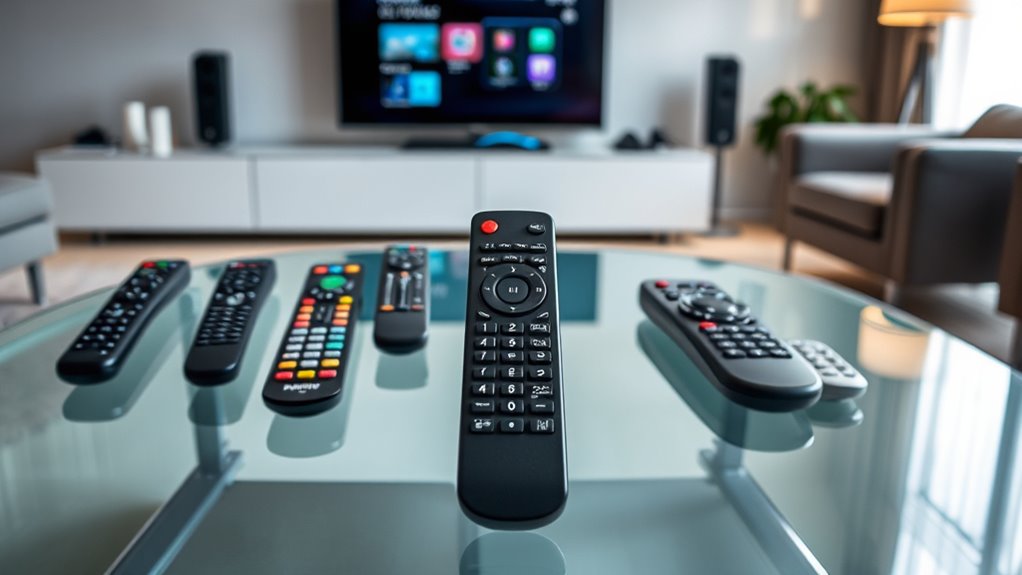
Hybrid and upgradable remotes are rapidly transforming how you control your devices by offering greater flexibility and longevity. Hybrid remotes combine infrared, RF, and Wi-Fi technologies, giving you seamless device interoperability and control across multiple platforms. Upgradable remotes allow firmware and software enhancements through USB, Wi-Fi, or apps, keeping your remote compatible with new devices and features. These remotes often feature customizable interfaces, such as touchscreens and macro programming, enabling you to automate complex commands and tailor controls to your preferences. Wi-Fi connectivity extends control beyond line-of-sight, allowing remote access via smartphones and integration with smart home ecosystems. Overall, these innovations reduce clutter, improve functionality, and future-proof your entertainment setup, making hybrid and upgradable remotes essential in the evolving remote control market.
Frequently Asked Questions
How Has the Remote Control Changed Over Time?
You’ve seen remote controls evolve from simple wired devices to advanced, multifunctional gadgets. Today, you can control multiple devices with a single remote thanks to universal models. Wireless technology like RF, Bluetooth, and Wi-Fi has improved range and convenience, allowing you to operate your devices without line-of-sight. Voice control and smart home integration make remotes even smarter, giving you seamless control over your entertainment and connected devices.
Can You Convert IR Remote to RF?
You might think converting an IR remote to RF isn’t possible, but it absolutely is. You just need an RF transmitter or gateway that can learn IR signals and send them wirelessly. Many devices, like RF remote extenders or smart home hubs, can do this easily. With some DIY skills using microcontrollers like Arduino, you can even build your own IR-to-RF converter, expanding your remote’s capabilities beyond line of sight.
What Is the History of the Universal Remote?
You’re curious about the history of universal remotes. They started in 1985, when Philips introduced the first one that let you control multiple devices. Initially, they used infrared signals, which required line-of-sight. Over time, features like programming, macros, learning capabilities, and device databases were added. Today, remotes have evolved to include RF and Wi-Fi technology, making control more flexible and integrated into smart home systems.
What Is the Difference Between RF and IR Remotes?
Ever wondered why some remotes work from across the room? IR remotes use infrared light, needing direct line-of-sight and a clear path to your device, with a limited range. RF remotes, on the other hand, send radio waves that pass through walls and obstacles, offering greater distance and flexibility. They don’t need aiming, making them perfect for larger spaces. Which type suits your lifestyle better?
Conclusion
As remote controls continue to evolve, you’re on the brink of a new era where hybrids and upgrades could redefine convenience. Imagine a future where your device adapts seamlessly to your lifestyle, but the question remains: what innovations will open even greater control? Stay tuned, because the next leap could change everything you thought you knew about remote technology—if you’re ready to embrace the unexpected. The future of remote controls is just getting started.
